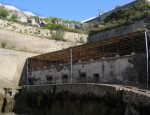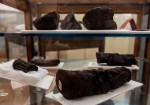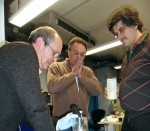When the wealthy town of Herculaneum was buried in pyroclastic flows from the eruption of Mount Vesuvius in 79 A.D., organic materials like wood, food and large quantities of poop were instantly carbonized by the superheated gases and ash, sucking all the water out of them and preventing their decay. Subsequent pyroclastic flows buried the city in 60 feet of hard volcanic rock that preserved the city and its contents for 2,000 years.
 Herculaneum was rediscovered in 1738 by Spanish engineer Rocque Joaquin de Alcubierre and Charles, the Bourbon King of the Two Sicilies, funded the first excavation of the site. In 1752, excavators unearthed the first carbonized papyri in a large villa that may have been owned by Lucius Calpurnius Piso Caesonius, father of Julius Caesar’s last wife Calpurnia of prophetic dream fame. Two years later, the excavation discovered a whole library with 1,800 scrolls tidily arranged on wall shelves. This is the only surviving complete ancient library in the world. The house was named the Villa of the Papyri after this unique discovery.
Herculaneum was rediscovered in 1738 by Spanish engineer Rocque Joaquin de Alcubierre and Charles, the Bourbon King of the Two Sicilies, funded the first excavation of the site. In 1752, excavators unearthed the first carbonized papyri in a large villa that may have been owned by Lucius Calpurnius Piso Caesonius, father of Julius Caesar’s last wife Calpurnia of prophetic dream fame. Two years later, the excavation discovered a whole library with 1,800 scrolls tidily arranged on wall shelves. This is the only surviving complete ancient library in the world. The house was named the Villa of the Papyri after this unique discovery.
 The few scrolls that could be opened were and found to be philosophical texts on Epicureanism, but the opening process damaged the scrolls, often destroying them. Researches have been trying ever since to find a way into the carbonized papyri that doesn’t obliterate an irreplaceable ancient artifact. The development of imaging technology like X-ray and CT scanning holds tantalizing promise for a non-invasive exploration of the texts, but there have been problems making it work.
The few scrolls that could be opened were and found to be philosophical texts on Epicureanism, but the opening process damaged the scrolls, often destroying them. Researches have been trying ever since to find a way into the carbonized papyri that doesn’t obliterate an irreplaceable ancient artifact. The development of imaging technology like X-ray and CT scanning holds tantalizing promise for a non-invasive exploration of the texts, but there have been problems making it work.
 From 2007 through 2012, the Enhanced Digital Unwrapping for Conservation and Exploration (EDUCE) program at the University of Kentucky attempted to read some Herculaneum scrolls in the collection of the Institut de France using a micro-CT scanner custom built for reading papyrus as opposed to human innards. They had some success at creating virtual models of the scrolls, revealing how dense and wavy the layers were and unwrapping them to their full length using image algorithms, but the lettering was a tough nut to crack because the carbonization made it all but impossible for the scanner to differentiate between the carbon-based ink and the papyrus.
From 2007 through 2012, the Enhanced Digital Unwrapping for Conservation and Exploration (EDUCE) program at the University of Kentucky attempted to read some Herculaneum scrolls in the collection of the Institut de France using a micro-CT scanner custom built for reading papyrus as opposed to human innards. They had some success at creating virtual models of the scrolls, revealing how dense and wavy the layers were and unwrapping them to their full length using image algorithms, but the lettering was a tough nut to crack because the carbonization made it all but impossible for the scanner to differentiate between the carbon-based ink and the papyrus.
Here’s a video of the EDUCE team scanning a Herculaneum scroll in 2010. You can see the results at the end and the one letter they point to is just a slightly darkish blur unreadable.
[youtube=http://youtu.be/885wc3sA7d0&w=430]
 Now a new study published in Nature Communications reports that a similar imaging technique, X-ray phase-contrast tomography, has been able to pick out letters from the scrolls. The research team, led by Vito Mocella of the Italian National Research Council, took a fragment from an unwrapped scroll and one intact scroll from the Institut de France to Grenoble where the European Synchrotron particle collider lives. The high-energy beams from the synchrotron reflect back from the ever-so-slightly raised letters (carbon-based ink doesn’t soak into papyrus; it sits on top of it) at a different phase than they do from the papyrus. researchers measured the phase difference and were able to recreate the letters.
Now a new study published in Nature Communications reports that a similar imaging technique, X-ray phase-contrast tomography, has been able to pick out letters from the scrolls. The research team, led by Vito Mocella of the Italian National Research Council, took a fragment from an unwrapped scroll and one intact scroll from the Institut de France to Grenoble where the European Synchrotron particle collider lives. The high-energy beams from the synchrotron reflect back from the ever-so-slightly raised letters (carbon-based ink doesn’t soak into papyrus; it sits on top of it) at a different phase than they do from the papyrus. researchers measured the phase difference and were able to recreate the letters.
This video gives a quick glimpse into the scanning process, but you can’t really discern the letter here either because the actual identification is done after the scan.
[youtube=http://youtu.be/JlWJ68DJGM0&w=430]
Mocella and his team show that they were able to make out two previously unreadable sequences of capital letters from a hidden layer of the unrolled scroll fragment. The team interprets them as Greek words: ΠΙΠΤΟΙΕ, meaning “would fall”, and ΕΙΠΟΙ, meaning “would say”. Even more exciting for scholars, the team was able to pick out writing on the still-rolled scroll, eventually finding all 24 letters of the Greek alphabet at various points on the tightly bundled document.
Even though the current scans are mostly a proof of concept, the work suggests that there will soon be a way to read the full works on the rolled scrolls, the team says. “We plan to improve the technique,” says Mocella. “Next spring we have an allowance to spend more time at the Grenoble synchrotron, where we can test a number of approaches and try to discern the exact chemical composition of the ink. That will help us improve the energy setting of the beam for our scan.”
 They’ll also collaborate with University of Kentucky computer scientist Dr. Brent Seales who spearheaded the EDUCE project. His work in mapping out the physical structure of the scrolls will be invaluable in helping place the letters in their proper order so the texts can actually be read rather than individual letters identified.
They’ll also collaborate with University of Kentucky computer scientist Dr. Brent Seales who spearheaded the EDUCE project. His work in mapping out the physical structure of the scrolls will be invaluable in helping place the letters in their proper order so the texts can actually be read rather than individual letters identified.
This is an important breakthrough for exploring other kinds of historical texts as well, like medieval palimpsests that have inaccessible writing in the binding or between glued pages, but if it does prove effective in reading Herculaneum’s carbonized scrolls, it could strike a motherlode of ancient sources. The scrolls that have been read so far all came from one room and they’re all in Greek. Archaeologists believe there may be a second library of Latin scrolls. If that’s true and more scrolls are found, a non-invasive means to read them could rediscover any number of lost ancient books. A virtual reality model of the Villa of the Papyri created at the UCLA’s Experiential Technologies Center conveys how large the structure is and how much is left to excavate.
[youtube=http://youtu.be/zxSgddcivHU&w=430]